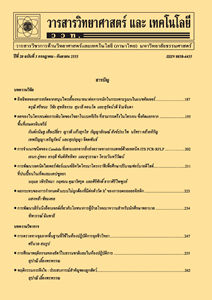การหาปริมาณของแคตอิออนในใบมะรุมพันธุ์ข้าวเหนียวและพันธุ์กระดูกด้วยเทคนิค Capillary Electrophoresis
Main Article Content
Abstract
บทคัดย่อ
ใบมะรุมสามารถนำมาใช้ประกอบอาหารหรือทำให้แห้งและบดเป็นผงก่อนบรรจุในแคปซูลเพื่อขายเป็นอาหารเสริมกันมาก เพราะมีข้อมูลว่าใบมะรุมมีปริมาณแคตอิออนที่มีประโยชน์ต่อร่างกาย งานวิจัยนี้จึงมีจุดประสงค์ที่จะหาปริมาณแคตอิออนในใบมะรุม 2 พันธุ์ ที่ปลูกกันมากในประเทศไทย คือ พันธุ์ข้าวเหนียวและพันธุ์กระดูก โดยใช้เทคนิค capillary electrophoresis ซึ่งใช้สารละลาย 12 mM imidazole, 15 mM alanine และ 3 mM 18 crown 6 ether ที่ pH 6.0 เป็น background electrolyte ศักย์ไฟฟ้าที่ใช้มีค่า +25 kV และทำการตรวจวัดที่ความยาวคลื่น 206 nm ผลการทดลองพบว่าใบมะรุมมีปริมาณโพแทสเซียม แคลเซียม และแมกนีเซียมในพันธุ์ข้าวเหนียวเท่ากับ 1.78, 1.19 และ 0.24 % สำหรับในพันธุ์กระดูกมีค่า 1.52, 2.47 และ 0.42 % ตามลำดับ
คำสำคัญ : ใบมะรุม; แคตอิออน; โพแทสเซียม; แคลเซียม; แมกนีเซียม; แคพิลลารีอิเล็กโทรโฟรีซิส
Abstract
Moringa leaves can be eaten fresh cooked or stored as dried powder in capsule in order to use as a supplementary food. Several information shows Moringa leaves contain cations which are useful to human health. Aim of this research was to determine the cations in Moringa Oleifera and Moringa Stenopetala leaves, which are commonly grown in Thailand by capillary electrophoresis technique. The experiment performed on capillary column 45 cm length with positive applied potential 25 kV. The composition of 12 mM imidazole, 15 mM alanine and 3 mM 18 crown 6 ether at pH 6 was used as background electrolyte and detected at wavelength 206 nm. The results showed potassium, calcium and magnesium ions in Moringa Oleifera leaves were 1.78, 1.19 and 0.24 %; whereas in Moringa stenopetala leaves were 1.52, 2.47 and 0.42 %, respectively.
Keywords: Moringa leave; cation; potassium; calcium; magnesium; capillary electrophoresis

